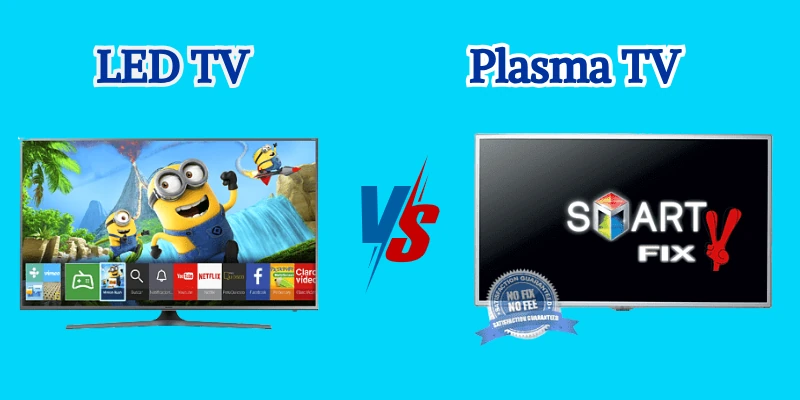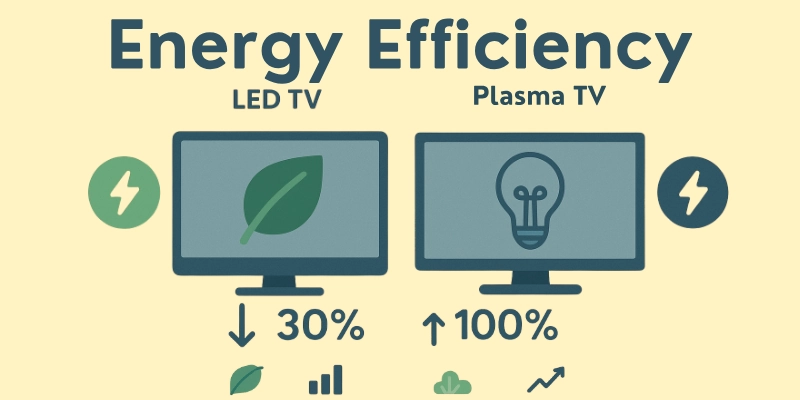LED TV vs Plasma TV: Which One is Right for You?
Published: 28 Apr 2025
Choosing the perfect television can feel overwhelming with so many types and technologies available today. Two major options people often compare are LED TV and Plasma TV. While both offer excellent viewing experiences, they work differently and suit different needs.

LED TVs use advanced light-emitting diodes to create bright and sharp images, making them a favourite for modern households. Plasma TVs, though older, are known for their deep blacks, smooth motion, and rich colours, providing a cinema-like experience.
In this article, we will explore the key differences between LED TV vs Plasma TV, helping you make a clear and confident choice based on your budget, room setup, and personal preferences.
Quick Comparison Table: LED TV vs Plasma TV
Here’s a quick comparison of LED TV vs Plasma TV:
| Feature | LED TV | Plasma TV |
| Display Technology | LED-backlit LCD | Gas-filled plasma cells |
| Picture Brightness | Very bright, ideal for light | Best in dark rooms |
| Energy Efficiency | High energy efficiency | Higher power consumption |
| Lifespan | Long, low risk of burn-in | Shorter, risk of burn-in |
| Availability | Widely available | Rare, mostly discontinued |
Plasma TV vs LED TV: Key Comparison
Let’s talk about all the key differences Plasma TV vs LED TV in detail to choose better one:
1. Display Technology
The core technology behind LED and Plasma TVs is quite different.
LED TV:
- Uses LED backlighting behind an LCD panel.
- Offers brighter displays compared to Plasma.
- Available in both edge-lit and full-array designs.
- Energy-efficient and generates less heat.
- Commonly used for ultra-slim TV designs.
Plasma TV:
- Uses small cells filled with gas to create images.
- Produces deep blacks and better color accuracy.
- Works best in dim lighting for clear pictures.
- Consumes more power compared to LEDs.
- Heavier and thicker in design.
2. Picture Quality
Picture clarity varies a lot between LED and Plasma TVs.
LED TV:
- Brighter screens ideal for well-lit rooms.
- Colour reproduction is strong but sometimes less natural.
- Contrast depends on backlight technology.
- Some models suffer from limited viewing angles.
- Great for daytime viewing.
Plasma TV:
- Superior contrast levels with rich blacks.
- Smoother motion for fast-paced scenes.
- Excellent colour accuracy and depth.
- Better viewing angles without colour loss.
- Performs best in darker rooms.
3. Energy Efficiency
Power consumption is important, especially for long-term use.
LED TV:
- Highly energy-efficient compared to Plasma.
- Generates less heat, reducing cooling needs.
- Good choice for eco-conscious buyers.
- Lower electricity bills over time.
- LED TVs are built with energy-saving in mind.

Plasma TV:
- Consumes more electricity due to gas technology.
- Generates noticeable heat during operation.
- Older models are less efficient than modern LEDs.
- Not ideal for energy-saving goals.
- Increased operating costs over time.
4. Durability and Lifespan
How long a TV lasts matters for your investment.
LED TV:
- Longer lifespan with minimal image degradation.
- LEDs gradually dim over many years.
- Designed to last 100,000 hours or more.
- Low risk of screen burn-in.
- Well-suited for daily and mixed usage.
Plasma TV:
- Shorter lifespan compared to LEDs.
- Risk of screen burn-in with static images.
- Image quality can degrade over time.
- Needs careful usage to avoid permanent marks.
- Better for movie nights than gaming or menus.
5. Price and Availability
Pricing and market availability can influence your choice.
LED TV:
- Widely available in all sizes and brands.
- Affordable models start from budget to premium.
- Continually improving with new tech like QLED and OLED.
- Many sales and discounts available.
- Easy to find both online and in stores.
Plasma TV:
- Mostly discontinued by major manufacturers.
- Hard to find new models; mostly used markets.
- Initially cheaper for large screen sizes.
- Some enthusiasts still prefer Plasma quality.
- Repair and support options are limited.
Which is Better?
Today, LED TVs are considered better for most users because they are energy-efficient, slim, widely available, and have excellent brightness for all environments.

Plasma TVs still offer outstanding colour accuracy and deep blacks but are no longer produced and consume more power. If you want the best modern experience, LED is the way to go.
Conclusion
LED TVs have become the standard choice for most buyers thanks to their brightness, slim design, and energy savings. Plasma TVs were once famous for their colour quality and deep blacks, but they are harder to find today and use more power.
If you are buying a new TV, LED models offer more options, better efficiency, and long-term reliability. Choose based on your viewing environment and budget, but for most people, an LED TV is the clear winner.
FAQs about LED TV vs Plasma TV
Here are some of the most FAQs related to LED TV vs Plasma TV:
Plasma TVs have better black levels and colour accuracy, but LED TVs are brighter, more energy-efficient, and widely available today.
No, LED TVs generally have a longer lifespan and are less prone to issues like burn-in compared to Plasma TVs.
No, major manufacturers stopped producing Plasma TVs around 2014 due to higher costs and energy use.
Yes, LED TVs perform very well in bright environments because they produce very high brightness levels.
Plasma TVs are usually heavier and bulkier than LED TVs because of their older technology and thicker screens.
Yes, Plasma TVs consume more electricity and produce more heat than LED TVs.
Yes, Plasma TVs are prone to burn-in if static images are displayed for long periods without movement.
Plasma TVs handle fast motion better, but modern LED TVs with high refresh rates also perform very well.
LED TVs come in a wide range of prices, from affordable models to premium high-end options.
Repair services for Plasma TVs are limited since parts are becoming harder to find, but some specialized shops still offer repairs.

- Be Respectful
- Stay Relevant
- Stay Positive
- True Feedback
- Encourage Discussion
- Avoid Spamming
- No Fake News
- Don't Copy-Paste
- No Personal Attacks

- Be Respectful
- Stay Relevant
- Stay Positive
- True Feedback
- Encourage Discussion
- Avoid Spamming
- No Fake News
- Don't Copy-Paste
- No Personal Attacks





